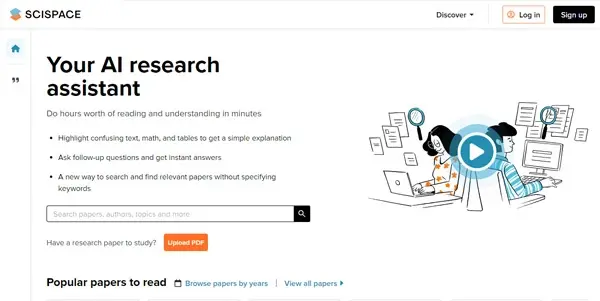Scispace

An AI to help you understand and easily read scientific literature (research papers, etc.)
Scispace: Demystifying Scientific Literature with AI
Navigating the complex world of scientific literature can be daunting, even for seasoned researchers. Scispace is an AI-powered tool designed to simplify this process, making research papers and other scientific documents more accessible and understandable. This article explores its capabilities, benefits, and how it compares to similar tools.
What Scispace Does
Scispace is an AI tool that helps users quickly grasp the key information within scientific literature. It acts as an intelligent intermediary, processing complex research papers and presenting the core findings in a more digestible format. Rather than requiring painstaking reading of lengthy articles, Scispace allows researchers to efficiently extract crucial details, saving valuable time and improving comprehension.
Main Features and Benefits
Scispace boasts several features that contribute to its effectiveness:
Summarization: Scispace provides concise summaries of scientific papers, highlighting the main findings, methodology, and conclusions. This significantly reduces the time spent reading lengthy articles while ensuring that critical information isn't missed.
Key takeaway extraction: The tool identifies and emphasizes the most important aspects of the research, allowing users to focus on the core contributions without getting bogged down in intricate details.
Improved comprehension: By simplifying complex scientific jargon and presenting information in a clear, organized manner, Scispace improves the overall comprehension of research papers, regardless of the user's background in the specific field.
Efficient research: Researchers can quickly scan multiple papers and identify those most relevant to their needs, accelerating the research process considerably.
Cross-referencing capabilities (potential future feature): While not currently confirmed, future development may include the ability to cross-reference findings across multiple papers, enhancing the synthesis of information and identifying potential research gaps.
Use Cases and Applications
Scispace's applications are widespread across various scientific disciplines:
Students: Students can use Scispace to quickly grasp the core concepts of complex research papers for assignments and studies.
Researchers: Researchers can leverage Scispace to efficiently review a large volume of literature, identify relevant studies, and stay updated on advancements in their fields.
Healthcare professionals: Medical professionals can utilize Scispace to quickly understand the latest research findings related to specific diseases and treatments.
Science communicators: Scispace can aid in translating complex scientific findings into more accessible language for public consumption.
Comparison to Similar Tools
Several other tools offer similar functionalities, such as semantic search engines and AI-powered literature summarizers. However, Scispace differentiates itself through (potential features pending further development and information):
Focus on scientific literature: Unlike general-purpose summarizers, Scispace is specifically designed to handle the complexities and nuances of scientific writing.
User-friendly interface: A streamlined and intuitive interface ensures ease of use, regardless of technical expertise.
(Potentially superior accuracy): While requiring more data to substantiate, Scispace may offer improved accuracy in identifying and summarizing key findings compared to some competing tools. This would need further benchmarking against competitors.
(Note: A direct comparison requires specifying competing tools and conducting a thorough performance evaluation.)
Pricing Information
Scispace is currently offered free of charge. This makes it an accessible resource for researchers and students of all backgrounds. Future pricing models may be introduced, but this information is not available at this time.
Conclusion
Scispace presents a valuable tool for anyone struggling with the comprehension and processing of scientific literature. Its user-friendly interface, AI-powered capabilities, and free accessibility make it a significant asset for students, researchers, and professionals alike. As the tool continues to develop, its potential to revolutionize how we engage with scientific information becomes increasingly apparent.